
* In the late 1960s, the Cessna company entered the executive jet market with the twin-jet "Citation" -- which would prove successful, and lead to a diverse family of twin-jets that continues in production in the 21st century. This document provides a history and description of the Cessna Citation family. A list of illustration credits is provided at the end.
* In 1968, to keep up with the growing market for executive business jets, the Cessna corporation announced their entry, the "Fanjet 500", to be powered by twin Pratt & Whitney Canada (PWC) JT15D turbofans. The prototype performed its initial flight on 15 September 1969. The development program was protracted, with considerable changes in the production machine from the initial prototype -- including a stretched forward fuselage, repositioned engine nacelles, a larger tail, and a tailplane with greater dihedral. The aircraft was certified as the "Model 500 Citation" in the fall of 1971, with customer deliveries following.
The Citation -- "sans suffixe"; all other Citation variants had suffixes -- was an all-metal aircraft, with low-mounted tapered wings, a tapered tailplane, a swept tailfin with a forward fillet, a fixed ventral fin under the tail, and tricycle landing gear. The Citation was designed with economy in mind, instead of performance; turboprop-class speed was seen as satisfactory.
The wing had a slight dihedral, while the tailplane had a steeper dihedral. Flight control surfaces were conventional: ailerons, one-piece flaps, elevators, rudder, and trim tabs. All the flight control surfaces were manually actuated, except for electrically-driven flaps, and an electrically-driven elevator trim tab with manual backup. There was also a hydraulically-operated speed brake on top of each wing.
The wings had de-icing boots outboard; apparently the wings had electrical de-icing inboard, since de-icing boots would have thrown ice chunks into the turbofans, but photos show de-icing boots on the tailplane and tailfin. Engine bleed air was used to de-ice the windshield and the engine inlet, with a backup alcohol de-icer for the windshield.
The Citation was powered by JT15D-1 turbofans, with 980 kN (1,000 kgp / 2,200 lbf) thrust each -- with the series later updated to the JT15D-1A and then JT15D-1B variants, featuring the same thrust, but incorporating fixes and minor refinements. There were integral fuel tanks in the wings, total capacity being 2,135 liters (564 US gallons).
All gear assemblies had single wheels, being hydraulically actuated, with the main gear retracting in the wings toward the fuselage -- the wheels remaining exposed after retraction -- and the steerable nose gear retracting forward. There were two crew, with seating for four or five passengers, plus a refreshment center in front and a lavatory in the rear. An optional layout provided seats for six or seven passengers. Maximum cabin width was 1.5 meters (4 feet 11 inches) and maximum height was 1.32 meters (4 feet 4 inches).
There was a front-hinged door on the front left fuselage, with tip-out steps, plus an emergency exit opposite it on the right fuselage -- and four windows on each side. There was a baggage hold in the nose, with tilt-up doors on both sides; there was no rear baggage hold, though eventually an update was offered to rig one up in unused space behind the pressure bulkhead. The nose was in a distinctive "duckbill" configuration, being wide and broad, the nose clearly being inspired by later models of the Cessna 400-series prop twins. Avionics were conventional, with a weather radar included as standard.
The original Citation provided something of a baseline for all Citations to follow:
Beyond those baseline features, there would be wide variations in configuration.
The early Citation production machines led to an updated variant, the "Citation I", introduced in 1976, with wingspan stretched from 13.4 to 14.35 meters (43 feet 11 inches to 47 feet 1 inch); thrust reversers; and increased maximum take-off weight (MTOW).
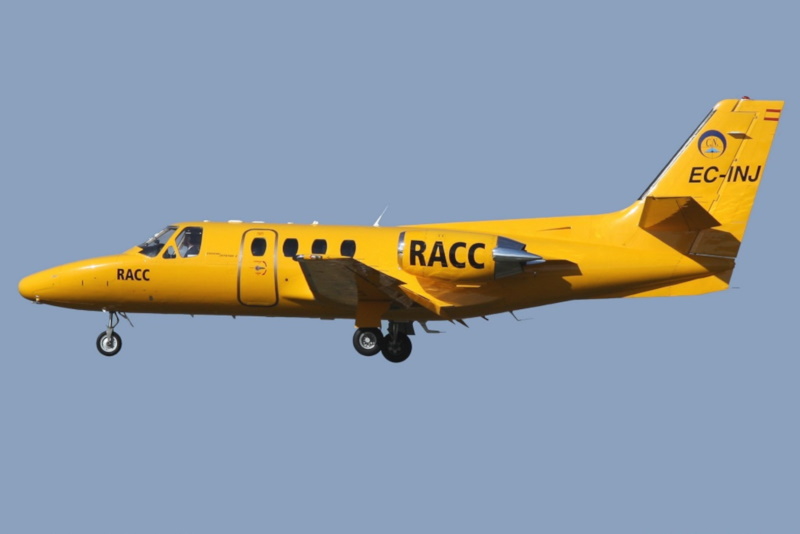
The next year, 1977, Cessna introduced the "Model 501 Citation I/SP" -- which was much the same, but configured for single-pilot operation. The standard Citation could also be flown by a single pilot who possessed the proper certification.
_____________________________________________________________________
CESSNA MODEL 500 CITATION I:
_____________________________________________________________________
wingspan:
14.35 meters (47 feet 1 inch)
wing area:
25.9 sq_meters (278.5 sq_feet)
length:
13.26 meters (43 feet 6 inches)
height:
4.37 meters (14 feet 3 inches)
empty weight:
3,008 kilograms (6,630 pounds)
MTO weight:
5,375 kilograms (11,850 pounds)
maximum speed:
750 KPH (465 MPH / 405 KT)
cruise speed:
660 KPH (410 MPH / 355 KT)
service ceiling:
12,500 meters (41,000 feet)
range, max fuel:
2,460 kilometers (1,530 miles / 1,328 NMI)
_____________________________________________________________________
Total production of Citation, Citation I, and Citation I/SP machines was 689, not counting the prototype.
* The "Model 550 Citation II" was announced in 1976, with initial flight on 31 January 1977; certification and initial deliveries were in 1978. The Citation II was generally similar to the Citation I, except for changes including:
Empty weight grew by about 10%. A single-pilot version, the "Citation II/SP", was also offered.
* The Citation II was later updated as the "Model 550B Citation Bravo", with initial flight on 25 April 1995, certification in 1996, and deliveries from 1997. The Bravo was a "facelift" of the II, an effort to extend sales of a machine was gradually being superseded by newer Citation lines. The Bravo looked much like the II, but featured new kit including:

* The Citation II was followed by the "Model S550 Citation S/II", which was announced in 1983. It performed its initial flight on 14 February 1984, with certification and deliveries before the end of 1984. It was a Citation II fitted with a new "supercritical" wing -- this technology being introduced by Cessna on the "Citation III", discussed later -- as well as improved JT15D-4B turbofans -- with the same baseline performance as their predecessors, but better high-altitude performance.
The Citation S/II's wing visibly differed from that of its predecessor by having a noticeable "leading-edge root extension (LERX)" inboard on each wing. The wingspan was further stretched by 14 centimeters (5.5 inches), to 15.9 meters (52 feet 2 inches). Wing and tailplane de-icing was by liquid anti-freeze, with tailfin de-icing deleted. Fuel capacity was further increased by 16%, to 3,263 liters (862 US gallons). Passenger accommodations were updated, with the baggage space increased.
_____________________________________________________________________
CESSNA MODEL S550 CITATION S/II:
_____________________________________________________________________
wingspan:
15.9 meters (52 feet 2 inches)
wing area:
31.83 sq_meters (342.6 sq_feet)
length:
14.39 meters (47 feet 8 inches)
height:
4.57 meters (15 feet)
empty weight:
3,665 kilograms (8,060 pounds)
MTO weight:
6,850 kilograms (15,100 pounds)
cruise speed:
745 KPH (465 MPH / 405 KT)
service ceiling:
13,100 meters (43,000 feet)
range, max fuel:
3,700 kilometers (2,300 miles / 2,000 NMI)
_____________________________________________________________________
The Citation S/II was also available with a wide door, for cargo or air ambulance use. A number of them were sold as air ambulances; at least two, configured for aerial remote sensing, were sold to the Chinese Academy of Sciences. The Citation II and S/II were manufactured more or less in parallel to end of production in 1996, with 688 and 160 manufactured respectively -- and then 336 Bravos built to end of production in 2006.
* The US Customs & Border Protection obtained ten Citation IIs, fitted with a multimode radar -- originally the AN/APG-66(V) from the F-16 fighter, later the Selex ES Vixen 500E -- and an AN/AAS-36 forward-looking infrared (FLIR) imaging turret. These machines, named "Interceptors", saw extensive service in the US and Latin America.
They were retired in 2019; four were obtained by Coulson Aviation, a fire-fighting outfit based in British Columbia, Canada, for use as "lead" aircraft, to spot fires and direct air tankers for retardant drops. The FLIR turret, useful for spotting fires, was a particular plus to Coulson. The aircraft were refurbished and given updates.

The US Navy obtained 15 modified Citation IIs as the "T-47A", with the company designation of "Model 552", as radar trainers. The T-47A featured:
All but one of the T-47As were lost in a disastrous hangar fire in Topeka, Kansas, in 1993. They were replaced with modified Rockwell T-39 Saberliners.
BACK_TO_TOP* Having lengthened the Citation I to come up with the Citation II, Cessna then extended the Citation II in turn to come up with the "Model 560 Citation V". A prototype performed its initial flight on 18 August 1987, with deliveries beginning in 1989.
The Citation V was very much the like Citation S/II, with the supercritical wing, but it was stretched by 52 centimeters (20 inches) to 14.91 meters (48 feet 11 inches), giving a maximum passenger capacity of 8 seats. It could be distinguished from the Citation S/II by the fact that it had seven windows on each side, instead of six. It featured PWC JT15D-5A turbofans with 13.55 kN (1,380 kgp / 2,900 lbf) thrust each.
The Citation V led to improved variants, the first being the "Citation V Ultra", announced in 1993, with deliveries from 1994. It featured JT15D-5D engines with 12.9 kN (1,315 kgp / 3,045 lbf) thrust each, and a Honeywell Primus 1000 flight deck.
_____________________________________________________________________
CESSNA MODEL S560 CITATION V ULTRA:
_____________________________________________________________________
wingspan:
15.9 meters (52 feet 2 inches)
wing area:
31.83 sq_meters (342.6 sq_feet)
length:
14.91 meters (48 feet 11 inches)
height:
4.57 meters (15 feet)
empty weight:
4,260 kilograms (9,395 pounds)
MTO weight:
7,395 kilograms (16,300 pounds)
cruise speed:
795 KPH (495 MPH / 430 KT)
service ceiling:
13,715 meters (45,000 feet)
range, max fuel:
3,650 kilometers (2,255 miles / 1,960 NMI)
_____________________________________________________________________
The Citation Ultra was replaced in turn by the "Citation Encore", which was announced in 1998, with initial deliveries in 2000. It featured PWC PW535A turbofans, with 15.12 kN (1,40 kgp / 3,400 lbf) thrust each; trailing link main landing gear; plus an updated interior. The main gear track was also reduced by 1.1 meters (3 feet 8 inches), to improve ground handling and crosswind landing behavior. Wing de-icing was by hot air bleed; a stall fence and small vortex generator vanes were installed on the wings to improve stall characteristics.
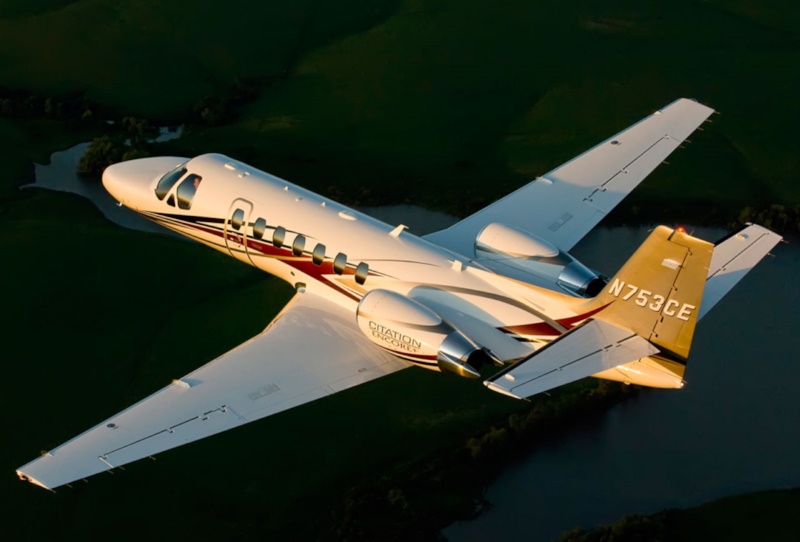
It had fuel capacity reduced by 6%, but better range due to the improved engines. In 2007, it was replaced by the "Encore+", with PW535B engines -- with the same thrust levels but featuring "full authority digital engine control (FADEC)" -- and a Rockwell Collins Pro Line 21 flight deck. 65 Encore+ machines were built to end of production in 2010, and the end of the original line of Citations. A total of 765 aircraft in the Citation V family were built in all, including 262 Citation Vs, 270 Ultras, 168 Encores, and 65 Encore+ machines.
* The US military obtained Citation V series machines for the light transport role, designations including:
They generally replaced older variants of the C-12 Huron (Beech King Air) in military service. The Pentagon also obtained five Citation Vs as the "OT-47B Tracker", kitted up with the same gear as used by the Customs Citation IIs, with these machines apparently focused on the drug interdiction mission.
BACK_TO_TOP* In 1989, Cessna announced a rethinking of the original Citation series, with the initial flight of the first "Model 525 CitationJet" on 29 April 1991, certification in 1992, and initial deliveries in 1993.
The CitationJet used the Citation II's forward fuselage, but was otherwise redesigned. It featured an underslung wing carry-through section, giving more internal space; it did have a tapered wing like that of the Citation II, though of a new supercritical design with a laminar cross-section, while adding a distinctive tee tail, with a swept tailfin and tapered tailplane. The CitationJet was powered by twin Williams FJ44-1A turbofans, with 8.5 kN (850 kgp / 1,900 lbf) thrust each, featuring inlet de-icing by hot engine bleed air.
The wing featured conventional flight controls, with large one-piece flaps; ailerons; elevators; rudder; and trim tabs. The wing was de-iced by engine bleed air, the laminar wing not being suited to the use of de-icing boots. The tailfin was steeply swept, with the tailplane being of tapered configuration as well; the tailfin had no de-icing, but the tailfin had de-icing boots. All flight controls were manually actuated, except for hydraulically-actuated flaps. There was a small speed brake on the top and bottom of each wing. All landing gear had single wheels.
The cockpit was arranged around a Collins Pro Line 21 flight deck, a color weather radar being standard. The windshield was de-iced by hot bleed air, with alcohol backup. The CitationJet could be flown by a single pilot. The door was on the forward left fuselage, being forward-hinged with flip-out stairs. There were four windows on each side of the fuselage, one window being in the passenger door. There was an emergency exit over the wing, behind the windows on the right. The CitationJet retained the two-door nose baggage hold, with the larger rear baggage hold accessed by a door below and behind the left engine.

The baseline CitationJet was refined as the "CitationJet CJ1", with initial deliveries in 2000. The CJ1 retained the FJ-44-1A engines, but had a modernized Pro Line 21 flight deck, and a modest increase in MTO weight. It was followed in turn by the enhanced "CitationJet CJ1+" -- which featured FJ-44-1AP engines, with dual FADEC; greater MTOW; a further updated Pro Line 21 flight deck; and an updated interior.
The CJ1+ led in turn to the "CitationJet M2", announced in 2011, with initial flight in 2012, and introduction in 2013. The M2 was powered by FJ44-1AP-21 turbofans, with more cruise thrust and better "hot & high" performance; it also had winglets, a Garmin 3000 flight deck, and a new cabin layout.
The "Citation M2 Gen2" was announced in 2021, with deliveries the next year. It had an improved interior with new lighting, new seats, USB charging ports in the seats, wireless charging, plus an illuminated airstair door, slight cockpit enhancements and more inflight-accessible storage.
* A stretched variant, the "Model 525A CitationJet CJ2", was introduced in 2000; it featured Williams FJ44-2C turbofans, and a fuselage extended from 12.98 to 14.53 meters (42 feet 7 inches to 47 feet 8 inches). There were six passenger windows on each side. The enhanced "CitationJet CJ2+" was delivered from 2006, featuring FJ44-3A-24 engines with FADEC, as well as updated avionics.
The further stretched "Model 525B CitationJet CJ3" first flew on 17 April 2003, with initial deliveries in late 2004. It was further extended to 15.59 meters (51 feet 2 inches), giving standard seating for six passengers, with seven windows on each side. It also had a Rockwell Collins Pro Line 21 flight deck. The enhanced "CJ3+" was introduced in 2014, and featured the Garmin 3000 flight deck, as well as LED lighting.

The still further stretched "Model 525C CitationJet CJ4" first flew on 5 May 2008, with initial deliveries in 2010. The CJ4 was extended to 16.26 meters (53 feet 4 inches), giving maximum passenger seating for nine. Oddly, the number of windows was reduced to five on the right side of the aircraft -- with no window in the door -- and six on the left, the frontmost window being spaced off from the other five, providing a recognition feature. The CJ4 also featured the modestly-swept wing of the Citation Sovereign (discussed later). It was powered by Williams FJ44-4A turbofans, with 15.12 kN (1,540 kgp / 3,400 lbf) and FADEC.
Three CJ4s were obtained in 2015 by the Japan Civil Aviation Bureau for the flight inspection role, carrying an instrument payload from Norwegian Special Missions (NSM) Company to make sure Japan's air systems were up to spec. BIRD Aerosystems of Israel is selling an "Airborne Surveillance, Intelligence & Observation (ASIO)" conversion of a CJ4, configured for maritime patrol with a search radar in a radome underneath the forward fuselage, an electro-optical / infrared imager turret, other sensors, a satellite link, and a mission system. BIRD offers a range of different ASIO configurations, to be fitted to a range of Citation variants. It appears a few have been sold so far, but the company is tight-lipped about its customers.
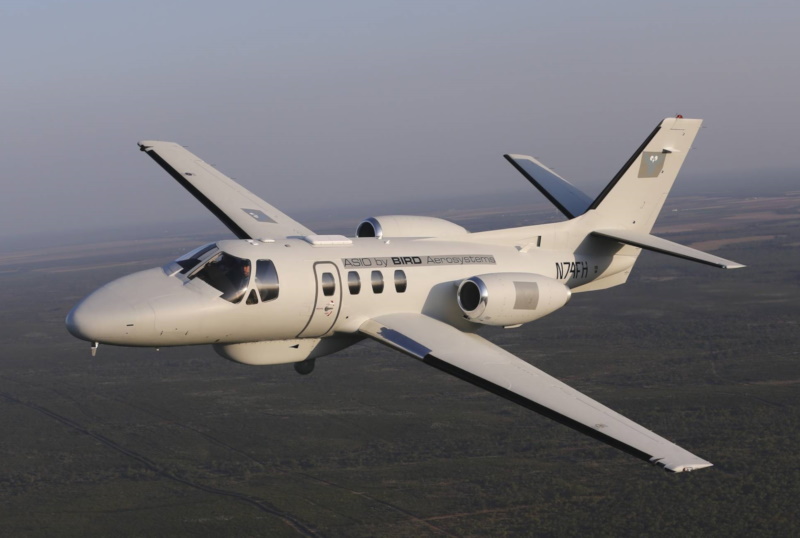
A "Gen2" CJ4 was introduced in 2021, the primary enhancements being for customer comfort, including modifications to the entry door system, an updated galley area, and an improved wireless connectivity system. The latest Pro Line 21 flight deck system was incorporated as well.
* Cessna also developed a "Very Light Jet (VLJ)", the "Model 510 Citation Mustang", to complement the larger members of the Citation family. The Mustang was announced in 2002, with initial flight on 13 April 2005, and deliveries from 2006.
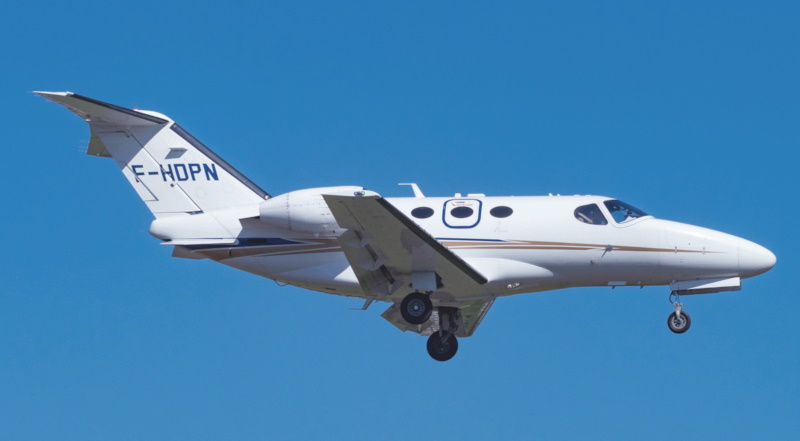
The Mustang looked like the CitationJet, with the tee tail, except that it was much shorter and the wings were modestly swept. It was powered by PWC PW615F turbofans with 6.5 kN (660 kgp / 1,460 lbf) each. There was a front-hinged door on the front left, with tip-out stairs, and an emergency exit over the right wing. Standard seating was for four passengers, though an additional passenger seat could be squeezed in. Maximum cabin width was 1.4 meters (4 feet 7 inches) and maximum height was 1.37 meters (4 feet 6 inches) -- a few inches narrower than the traditional CitationJet fuselage, but a few inches taller as well.
_____________________________________________________________________
CESSNA MODEL 510 CITATION MUSTANG:
_____________________________________________________________________
wingspan:
13.16 meters (43 feet 2 inches)
wing area:
50.4 sq_meters (543 sq_feet)
length:
12.37 meters (40 feet 7 inches)
height:
4.09 meters (13 feet 5 inches)
empty weight:
2,540 kilograms (5,600 pounds)
MTO weight:
3,930 kilograms (8,645 pounds)
cruise speed:
630 KPH (390 MPH (340 KT)
service ceiling:
12,500 meters (41,000 feet)
take-off field:
950 meters (3,110 feet)
landing field:
730 meters (2,380 feet)
range:
2,160 kilometers (1,345 miles (1,165 NMI)
_____________________________________________________________________
An enhanced version of the Mustang, the "High Sierra", was introduced in 2010 -- featuring high-end cabin furnishings, plus augmented avionics, including a synthetic vision system. The Mustang went out of production in 2017, 479 having been produced. The VLJ concept turned out to be flawed, with the lower price of the small jets not compensating for their lack of capability.
BACK_TO_TOP* In 1979, Cessna announced a departure from the existing Citation design series, working on a derivative that would have higher performance, transcontinental range, and more passenger comfort. The first of two flight prototypes of the "Model 650 Citation III" performed its initial flight on 30 May 1979, with deliveries from 1983. The Citation III featured:
The wing featured three-section, electrically-driven flaps of composite construction. There were four hydraulically-actuated spoilers on each wing, which were used as airbrakes and lift dumpers. The ailerons were hydraulically actuated; wing de-icing was by hot-air bleed. The tailplane was adjustable for flight trimming, The main gear featured twin wheels.
The first production machine, which was owned by golf superstar, and enthusiastic pilot, Arnold Palmer, set a number of "time to altitude" and speed records -- including a flight from Gander in Newfoundland to Le Bourget in Paris in 5 hours 13 minutes.
_____________________________________________________________________
CESSNA MODEL 650 CITATION III:
_____________________________________________________________________
wingspan:
16.31 meters (53 feet 6 inches)
wing area:
29.0 sq_meters (312 sq_feet)
length:
16.9 meters (55 feet 5 inches)
height:
5.12 meters (16 feet 10 inches)
empty weight:
5,355 kilograms (11,810 pounds)
MTO weight:
9,980 kilograms (22,000 pounds)
maximum speed:
910 KPH (565 MPH / 490 KT)
cruise speed:
875 KPH (545 MPH / 470 KT)
service ceiling:
16,000 meters (51,000 feet)
range:
4,350 kilometers (2,700 miles / 2,350 NMI)
_____________________________________________________________________
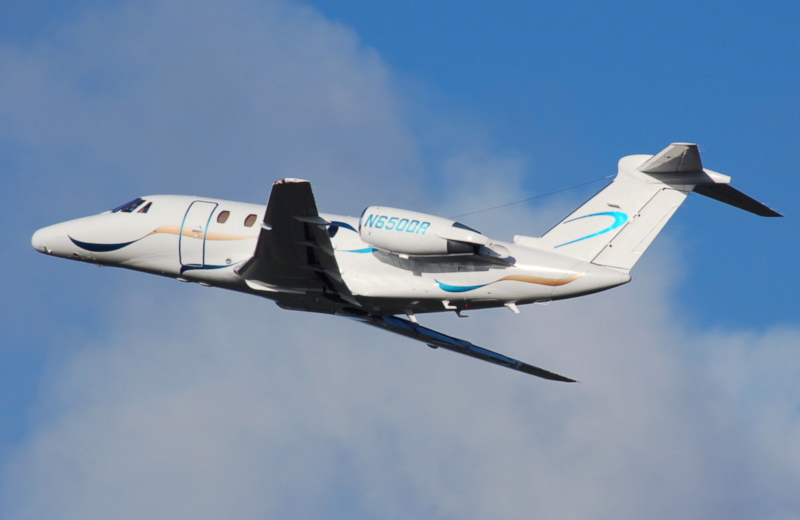
202 Citation IIIs were delivered to end of production in 1992. No "Citation IV" was produced; it was planned as a stretched follow-on to the Citation III, but it was canceled without being flown. Of course, as mentioned above, the Citation V was a stretched Citation II, not a follow-on to the Citation III.
The Citation III was followed by the cost-reduced "Citation VI", which was produced from 1991 to 1995 -- with 39 built -- as well as the more powerful "Citation VII", with TFE731-4R turbofans, providing 18.2 kN (1,850 kgp / 4,080 lbf) thrust. The Citation VII was produced from 1992 through 2000, with 119 built. One Citation VII was modified by European aerospace giant Airbus from 2021 as an "extra-performance wing (EFW)" demonstrator, to test highly-adaptive wing technologies with different combinations of spoilers, hinging, and dynamic shape-changing.
* The original Citation had been designed for docility and economy, with performance comparable to that of turboprop executive aircraft. Although the product was successful, the low performance led to gibes about the "Slowtation" or "Nearjet", that it was prone to "bird strikes from the rear". Cessna management decided to put the sneers to bed for good, announcing the high-performance "Model 750 Citation X", with coast-to-coast range, in 1990. Initial prototype flight was on 21 December 1993, with certification and initial deliveries in 1996 -- the development program having suffered from a number of delays. The first customer was, of course, Arnold Palmer.
The Citation X was largely a new design, though it did have a fuselage derived from that of the Citation VII, with the same cross-section, and had a similar general configuration: a low-wing executive jet with a tee tail and all-swept flight surfaces, with twin turbofans on the rear fuselage, and tricycle landing gear. The rear fuselage was "area ruled", avoiding abrupt changes in overall cross-section, which reduced drag. The Citation X could cruise at Mach 0.9, as compared to the Mach 0.8 of its competitors.

The Citation X had little parts commonality with the Citation VII, and the new machine was clearly racier in appearance, emphasized by an underslung wing with a 37-degree sweep at quarter-chord; it had well more powerful Rolls-Royce / Allison AE 3007 turbofans, in larger nacelles, with wider intakes. Early production used AE 3007C1 engines, with 28.7 kN (2,920 kgp / 6,440 lbf) thrust each. The Citation X was the first in the Citation line to use Rolls-Royce engines.
Each wing featured an aileron, three-segment Fowler flaps, two-segment leading-edge slats, and five spoilers -- being use for roll control, as airbrakes, or lift dumpers. Although winglets were then fashionable, the Citation X didn't feature them, the perception at the time being that for a high-speed aircraft, they were more trouble than they were worth.
The tailplane was all-moving, with rear pitch trimmers, instead of elevators, and the rudder had two sections. All flight controls were hydraulically actuated -- except for the upper rudder segment, which was electrically controlled -- with manual reversion in case of system failure. The Citation X was the first of the Citations to have powered flight controls.
The Citation X had a typical passenger capacity of six seats, in executive configuration. However, the cabin was cramped compared to the competition -- Cessna market research indicated that target customers would sacrifice comfort for performance. The cockpit was based on the Honeywell Primus 2000 flight deck.
_____________________________________________________________________
CESSNA MODEL 750 CITATION X:
_____________________________________________________________________
wingspan:
19.39 meters (63 feet 7 inches)
wing area:
48.96 sq_meters (527 sq_feet)
length:
22.05 meters (72 feet 4 inches)
height:
5.85 meters (19 feet 2 inches)
empty weight:
9,730 kilograms (21,450 pounds)
MTO weight:
16,195 kilograms (35,700 pounds)
max cruise speed:
950 KPH (590 MPH / 510 KT)
service ceiling:
15,550 meters (51,000 feet)
range, max fuel:
6,020 kilometers (3,740 miles / 3,255 NMI)
_____________________________________________________________________
Given the high performance of the Citation X users said, not entirely joking, they didn't have to cater flights any longer, since they didn't have time to eat. Arnold Palmer set a category speed record in his Citation X in September 1997, averaging 876 KPH (544 MPH / 473 KT) on a closed course of 5,000 kilometers (3,105 miles / 2,700 NMI), in under six hours. In that same year, the Citation X won the prestigious Collier Trophy, awarded by the US National Aeronautic Association.
Being an advanced design, reliability of the Citation X was poor at first, but the problems were gradually ironed out -- though the type would never have a reputation for reliability. Cessna built up their service organization to make sure users didn't get stranded with a defective aircraft.
In 2002, the Citation X was upgraded with AE 3007C-1 engines, with 30.1 kN (3,065 kgp / 6,765 lbf) thrust each, permitting shorter take-offs, an increase in MTOW of 180 kilograms (400 pounds), and full transcontinental flights with six or seven passengers. The updated Citation X, which did not get a new variant designation, also featured a modernized Honeywell Primus flight deck, and refinements that dealt with some of its handling quirks. Arnold Palmer got the first customer delivery.

In 2010, Cessna released a more significant make-over, originally designated the "Citation Ten", but sold as the "Citation X+". Initial flight of the first Citation X+ was on 17 January 2012, with customer deliveries later that year. The Citation X+ featured:
The Citation X series ended production in 2018, after manufacture of 338 machines. It was finally done in by the slow creep towards more comfortable executive jets with expanded cabin room, competitors having been able to approach the Citation X's higher cruise speeds.
BACK_TO_TOP* The Citation X was something of a "hot rod", being intended for buyers willing to pay the price for it. In 1994, Cessna announced a new design, a follow-on to the lower-cost Citation VII that leveraged off the Citation X -- with the first prototype of "Model 560XL Citation Excel" -- or just "XL" -- performing its initial flight on 29 February 1996.
The Excel was a hybrid design, featuring the wide cabin of the Citation III and X, shortened down, mating it to an unswept supercritical wing, based on that of the Citation V Ultra, and the tail from the Citation V. The Excel was powered by twin Pratt & Whitney Canada PW500 turbofans; an APU was optional. It had a Honeywell flight deck. The Excel could seat six to eight passengers in an executive configuration, and up to 9 in a high-density configuration. Production switched in 2004 to the updated "Citation XLS", with upgraded PW545B turbofans, and a Honeywell Primus 1000 flight deck.

The XLS was followed by the "Citation XLS+" in 2008, featuring PW545C turbofans with FADEC, providing 18.32 kN (1,879 kgp / 4,120 lbf) thrust each; a Collins Pro Line 21 flight deck; and a "pointier" nose, like that of the Citation X. The Garmin 5000 flight deck was later on offer. The "Citation XLS Gen 2" was introduced in 2022, with the same enhancements as the M2 Gen 2.
_____________________________________________________________________
CESSNA MODEL 560 CITATION XLS+:
_____________________________________________________________________
wingspan:
17.17 meters (56 feet 4 inches)
wing area:
48.96 sq_meters (527 sq_feet)
length:
16 meters (52 feet 6 inches)
height:
5.23 meters (17 feet 2 inches)
empty weight:
5,085 kilograms (12,800 pounds)
MTO weight:
19,165 kilograms (20,200 pounds)
cruise speed:
815 KPH (505 MPH / 440 KT)
service ceiling:
13,715 meters (45,000 feet)
range, max fuel:
3,440 kilometers (2,140 miles / 1,860 NMI)
_____________________________________________________________________
* The Excel series led to the "Model 680 Citation Sovereign", which was announced in 1998. Three flight prototypes were built, the first performing its initial flight on 27 February 2002; two static-test airframes were built as well. Initial customer deliveries were in 2004.
The Sovereign was effectively an Excel with a fuselage stretched by 2 meters (6 feet 7 inches), and a new-design wing. As introduced, the wing had a sweep of 16.3 degrees at quarter-chord, and had three electrically-actuated Fowler flaps. The tail arrangement was of cruciform configuration. It was powered by twin PW306C turbofans, with 25.7 kN (2,615 kgp / 5,770 lbf) thrust each, and featured a Honeywell Primus Epic flight deck.
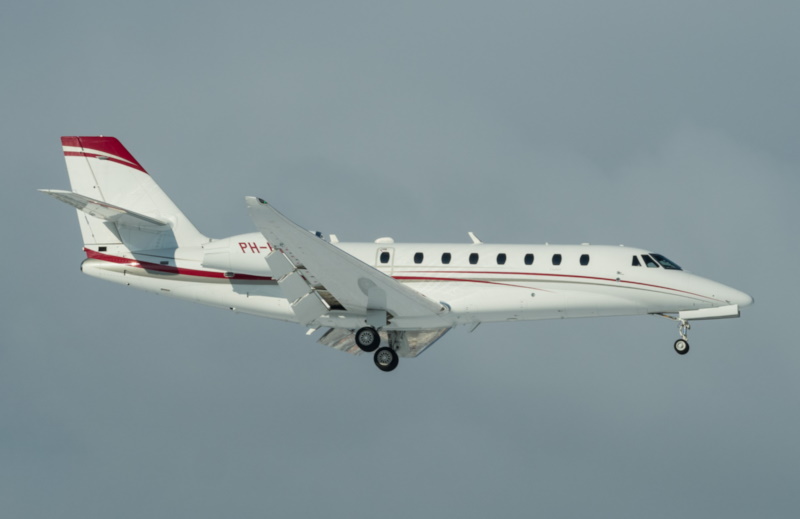
_____________________________________________________________________
CESSNA MODEL 680 CITATION SOVEREIGN+:
_____________________________________________________________________
wingspan:
22.04 meters (72 feet 4 inches)
wing area:
50.4 sq_meters (543 sq_feet)
length:
19.35 meters (63 feet 6 inches)
height:
6.20 meters (20 feet 4 inches)
empty weight:
8,270 kilograms (8,271 pounds)
MTO weight:
13,960 kilograms (30,775 pounds)
cruise speed:
850 KPH (530 MPH / 460 KT)
service ceiling:
14,000 meters (47,000 feet)
take-off field:
1,075 meters (3,530 feet)
landing field:
790 meters (2,600 feet)
range:
5,925 kilometers (3,680 miles / 3,200 NMI)
_____________________________________________________________________
The improved "Sovereign+" was introduced in 2012. It featured upturned wingtips -- not exactly the same as winglets, but still effective -- plus updated PW306D engines with 26 kN (2,655 kgp / 5,850 lbf) thrust, and a Garmin G5000 flight deck with touchscreen displays. Production was ended in 2021 in favor of the Citation Latitude (see below); 249 Sovereigns and 94 Sovereign+ machines had been built to that time.
BACK_TO_TOP* In 2008, Cessna announced the development of what was going to be the largest member of the Citation family to that time, the machine being named the "Columbus". It was to feature the latest technology, including new PWC PW810 turbofans. First deliveries were to be in 2014 -- but thanks to the "Great Recession", aircraft sales were soft, and so the Columbus was canceled in 2009.

As a result, the next Citation was the "Model 680A Citation Latitude", which was announced in 2011, with initial flight on 18 February 2014, and initial deliveries in 2015. It was Cessna's first entry into the "super-midsize" business jet class, being effectively a Sovereign+ with a new fuselage, providing stand-up room and a flat floor.
As introduced, the Latitude was made primarily of aircraft aluminum -- Cessna still wasn't keen on composites -- with the same flight surfaces as the Sovereign+, with the upturned wingtips, though it added twin fixed ventral fins. The landing gear had all twin wheels, the nose gear being hydraulically steerable. There was an airstair door, with a rail, on the front left fuselage, being manually opened and electrically closed. There was an emergency exit over the right wing, and five large passenger windows on each side -- not counting a small porthole in the emergency exit.
The cabin dimensions were considerably increased: maximum cabin width was 1.96 meters (6 feet 5 inches) and maximum height was 1.83 meters (6 feet). Normal passenger load was six, with a maximum of nine. There was a lavatory in the rear, with a baggage hold behind that. The baggage hold had an access door on the left fuselage, ahead of the engine. The baggage hold was accessible from the cabin.
The Latitude was powered by twin PWC PW306D1 turbofans with 26.3 kN (2,680 kgp / 5,905 lbf) thrust each. Standard seating was for six passengers, with a maximum of nine. It had a Garmin G5000 flight deck, same as for the Sovereign, with three large and four small flat-panel displays, plus touchscreen input. The G5000 system had a "synthetic vision" capability, providing virtual imagery of what's ahead of the aircraft. The windscreen shed rain with a hydrophobic coating, and featured electrical de-icing.
_____________________________________________________________________
CESSNA MODEL 680A CITATION LATITUDE:
_____________________________________________________________________
wingspan:
22.04 meters (72 feet 4 inches)
wing area:
50.4 sq_meters (543 sq_feet)
length:
18.97 meters (62 feet 3 inches)
height:
6.38 meters (20 feet 11 inches)
empty weight:
8,460 kilograms (8,655 pounds)
MTO weight:
13,870 kilograms (30,800 pounds)
cruise speed:
815 KPH (505 MPH / 440 KT)
service ceiling:
13,715 meters (45,000 feet)
take-off field:
1,090 meters (3,580 feet)
landing field:
755 meters (2,480 feet)
range:
5,000 kilometers (3,105 miles / 2,700 NMI)
_____________________________________________________________________
Three Latitudes were obtained by the Japan Air Self-Defense Force for air traffic system flight inspection using an NSM payload, the aircraft being delivered in 2020:2021.
* The Latitude led in its turn to the "Model 700 Citation Longitude", which was announced in 2012, and made its initial flight on 8 October 2016. Initial deliveries were in 2019. It was effectively a revival of the Columbus, based on the fuselage of the Latitude, stretched to add a seat row, along with a new wing -- featuring a sweep of 28.6 degrees at quarter-chord plus proper winglets, and a tee tail.
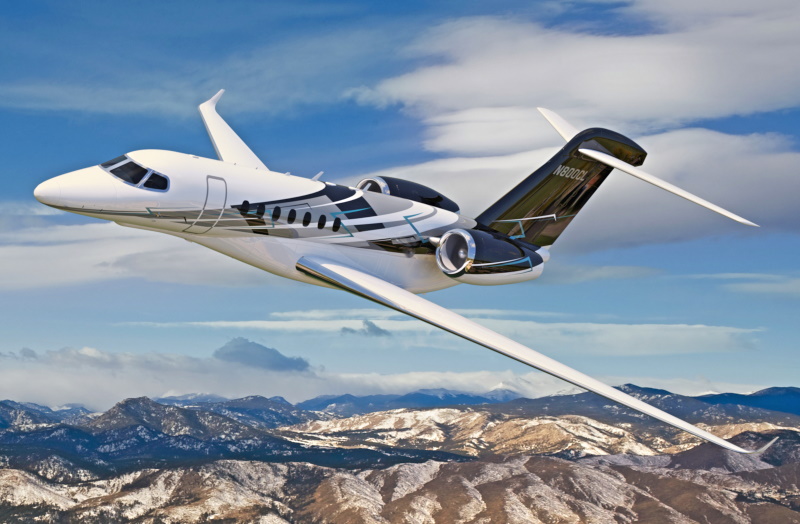
As introduced, it was powered by Honeywell HTF7700L turbofans, with 33.6 kN (3,425 kgp / 7,550 lbf) thrust each. Standard seating was for eight passengers, though 12 could be accommodated. It had a Garmin 5000 flight deck.
_____________________________________________________________________
CESSNA MODEL 700 CITATION LONGITUDE:
_____________________________________________________________________
wingspan:
22.04 meters (72 feet 4 inches)
wing area:
49.9 sq_meters (537 sq_feet)
length:
22.3 meters (73 feet 2 inches)
height:
5.92 meters (19 feet 5 inches)
empty weight:
8,460 kilograms (18,655 pounds)
MTO weight:
17,915 kilograms (39,500 pounds)
cruise speed:
880 KPH (550 MPH / 470 KT)
service ceiling:
13,715 meters (45,000 feet)
take-off field:
1,495 meters (4,900 feet)
landing field:
1,035 meters (3,400 feet)
range:
6,480 kilometers (4,030 miles / 3,500 NMI)
_____________________________________________________________________
One Longitude was obtained by the Japan Civil Aviation Bureau for calibration of navigation systems. In 2022, Cessna announced work on a maritime patrol aircraft (MPA) version of the Longitude. It would feature a belly dome for a sea-search radar, a long-range datalink, a retractable day-night imaging turret, and optional night-vision goggle (NVG)-compatible lighting. Nothing more was heard of it after the announcement.
* Following the Longitude, in 2015 Cessna announced the "Citation Hemisphere", which would be the biggest member of the Citation family. It was expected to have a range of 8,335 kilometers (5,180 miles / 4,500 NMI) at a cruise speed of Mach 0.9; a Primus Epic flight deck; a fly-by-wire flight control system from Thales; a further enlarged cabin, with a maximum diameter of 2.6 meters (102 inches); and a maximum passenger capacity of 15 seats, though as a luxury machine, in practice the passenger load might more typically be 4 to 8.
It was to be powered by advanced SNECMA Silvercrest turbofans -- but the Silvercrest program ran into problems. After examining the issue, Cessna stopped the Hemisphere program in 2019. It is likely to be resurrected in some form, but the 2020:2021 COVID-19 pandemic severely impacted the commercial aviation business, so efforts to that end were likely on hold for a time. To that time, over 8,000 Citations of all types had been delivered.
BACK_TO_TOP* One thing not mentioned in the text is that upgrades for older Citations have long been available from multiple vendors to bring them up to improved spec. However, that is an extremely complicated subject not worth discussing in detail. Enough to say they do exist.
Sources mention that in the 1980s, Cessna modified the S/II prototype, with had been previously modified from the original Citation II prototype, with twin pusher turboprop engines, driving five-bladed props, with a tee tail to keep the tailplane out of the way of the props. The aircraft was named the "Advanced Turboprop Testbed (ATPTB)"; it performed its first flight in December 1986. It was kept as secret as possible, presumably because Cessna didn't want to get the rumor mill going on a project that might not pan out. It didn't; what happened to the ATPTB is not known.
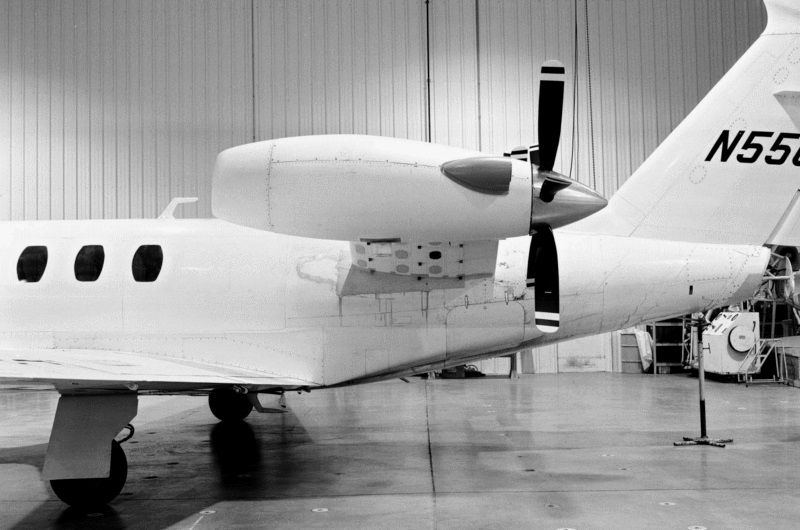
* The primary sources for the first release was the online Wikipedia, various volumes of JANE'S ALL THE WORLD'S AIRCRAFT, and the Cessna website.
* Illustrations details:
* Revision history:
v1.0.0 / 01 oct 18 / Released as THE CESSNA CITATION SERIES. v1.1.0 / 01 aug 19 / General clean-up. v1.2.0 / 01 jun 21 / Another general clean-up and update, changed title. v1.2.1 / 01 apr 23 / Review, update, & polish. v1.2.2 / 01 apr 25 / Review, update, & polish. (+)BACK_TO_TOP
